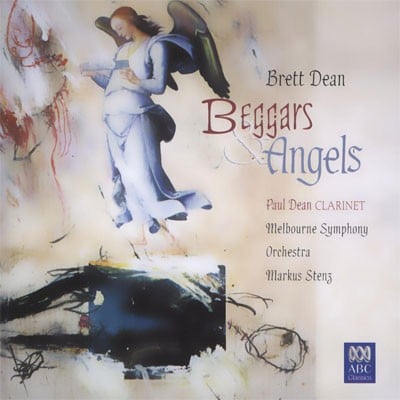3(II,III=picc).2.0.3(III=dbn)-4.2.2.1-timp.perc(3):I=4susp.cym/4tom-t/4wdbl/tabor(or lg SD)/2tgl(sm,lg)/ratchet; II=4tom-t/t.bells/BD/SD/tam-t/glsp/whip/susp.cym; III=4susp.cym/crot/tamb/5tom-t-harp-pft(=cel)-strings(min.12.10.8.6.5)
Abbreviations (PDF)
Bote & Bock
The idea for writing a clarinet concerto came into discussion two years ago while performing and recording trios with pianist Stephen Emmerson and my brother Paul. It was intended to become a double concerto, a companion piece for the Bruch concerto heard this evening, however it evolved increasingly into a solo concerto for clarinet, accompanied by a ‘largish’ orchestra.
The Ariel of the title has no Shakespearian overtones, but refers to a young American girl, Ariel Glaser, who died of AIDS in 1988, aged 7. Ariel’s mother, Elisabeth, had contracted the virus in 1981 during advanced pregnancy when an emergency blood transfusion was necessary. Elisabeth Glaser, wife of well known actor and director Paul Michael Glaser, went public with her family’s tragic story shortly after Ariel’s death. She became an outspoken AIDS campaigner and did much to increase public awareness and government recognition of the disease’s social consequences at a time when this was by no means taken for granted. Though without any specifically ‘programmatic’ inventions, Ariel’s Music pays tribute to this heroic woman who raised more than $30 million for paediatric AIDS research before her own tragic death of AIDS in December 1994.
The work is in two contrasting movements, unified by common motives. In the opening of the first movement (Elegy), a delicate texture heard in violins and cymbals spreads throughout the remainder of the strings while the solo clarinet introduces the most telling of the work’s motives, a tender, yearning leap of a major 9th.
This utterance, very hushed at first, collects other ideas along the way, waking more and more of the orchestra until the clarinet has to battle increasingly to have its song heard, Heading towards the work’s first peak, the solo voice seems to be losing the struggle and is indeed swallowed up, when an unexpected change of texture gives the clarinet a new lease of life. The following interplay between soloist and flutes, harp, piano and celeste, leads through various scherzo-like moments, however the slow downward sliding of the strings pulls us inevitably back to the distant, lamenting character of the opening.
New energy is found again in the opening of the second movement. The brass announce the dotted rhythmic motto first heard briefly in the first movement. This time it remains as a driving force throughout the ensuing Todestanz. The soloist embodies an anxious figure, forever trying to establish a dialogue with other solo voices within the orchestra (eg. Piano, viola, oboe, flutes). The title of the movement, Circumstances, attempts to show how this inherently lonely figure reacts to the varied situations confronting it, by turns agitated and restless, suddenly sensitive and somewhat injured, desperate and angry, even defiant. At the climax, a jagged, aggressive tutti exclamation of the rhythmic motto forces the soloist to a final, impassioned cry in the form of a high, tumbling cadenza against repeated whips from the orchestra. With all the energy then spent and the battle seemingly lost, the elegiac atmosphere of the first movement returns and the piece ebbs away, rocking gently into the distance.
© Brett Dean, August 1995
Reproduction Rights
This programme note can be reproduced free of charge in concert programmes with a credit to the composer
"... a monumental and chillingly effective work, dedicated to Ariel Glaser, who died of AIDS in 1988 at the age of seven... The composer has uncommon skill in orchestration and describes a very emotional situation with contemporary music that is both sympathetic and powerful but never offensive." (Theodore Jahn, International Clarinet Journal, Feb 2000)

Paul Dean / Melbourne Symphony Orchestra / Markus Stenz
ABC 476 160-6

